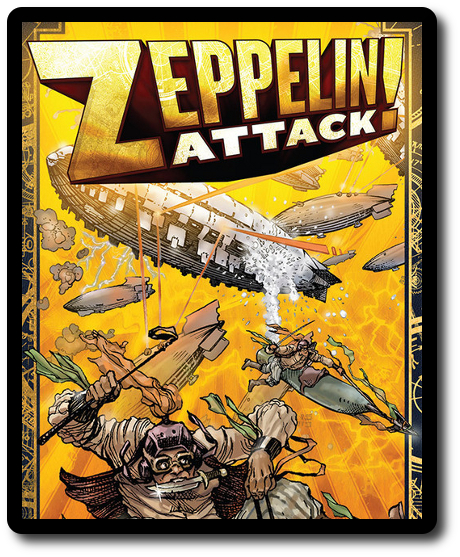
The Basics:
- For ages 10 and up (publisher suggests 12+)
- For 2 to 4 players
- Approximately 45 minutes to complete
Geek Skills:
- Counting & Math
- Logical & Critical Decision Making
- Reading
- Pattern/Color Matching
- Strategy & Tactics
- Hand/Resource Management
Learning Curve:
- Child – Easy
- Adult – Easy
Theme & Narrative:
- Take to the skies and crush your enemies with your floating armada
Endorsements:
- Gamer Geek approved!
- Parent Geek approved!
- Child Geek approved!
Overview
Only fools fight for land. The real prize is the sky above. True freedom can only be found between Heaven and Earth. Some wage war to claim it as their own, while others struggle to keep it open to all. Giant airships circle above like sharks waiting to swallow smaller prey. And in a way, the sky is very much like the oceans below. You must fight to survive and there is safety in numbers. Ready your parachute and load your gun. It’s time to fly or die.
Zeppelin Attack!, designed by Eric B. Vogel and published by Evil Hat Productions, is comprised of 52 Starter cards (13 per player), 6 Mercenary Operations Zeppelin cards, 6 Mercenary Attack Zeppelin cards, 8 Mercenary Attack cards, 6 Mercenary Defense cards, 8 Mercenary Operative cards, and 26 Fate cards. The cards are of excellent quality and very durable. The illustrations by Daniel Solis and Christian N. St. Pierre capture the game’s pulp theme perfectly, further enhancing the game play by keeping players locked in the narrative.
Game Set Up
To set up the game, first make the 4 Starter decks. Each Starter deck is made up of 13 cards and has the image of the main character it belongs to. These Starter decks contain a mix of Attack, Defense, and Operative cards. The Starter deck also includes the player’s Flagship, 2 starting Zeppelins, and 1 Experimental Zeppelin. When these 4 Starter decks are built, have each player select 1 or randomly give 1 to each player. Any Starter decks not used are returned to the game box.
Second, take the remaining cards and organize them into 6 different piles. There will be 1 Fate card pile, 1 Attack card pile, 1 Defense card pile, 1 Operative card pile, 1 Attack Zeppelin card pile and 1 Operations Zeppelin card pile.
Third, from the Fate card pile, remove 1 “3 Fate Point” and 1 “4 Fate Point” Fate card for each player. Hand these Fate cards to each player and add them to their Starting deck. Shuffle the remaining Fate cards and place them face-down in the middle of the playing area.
Fourth, shuffle the Attack, Defense, Operative, Attack Zeppelin, and Operations Zeppelin card piles and place each, face-up, next to the Fate cards in a row. These cards are collectively referred to as the Mercenary cards.
Fifth, each player should now look through their Starting deck and remove their Experimental Zeppelin card. Place these cards, face-up, at the end of the row of cards in the middle of the playing area. When completed, the middle of your playing area should look similar to the following image.
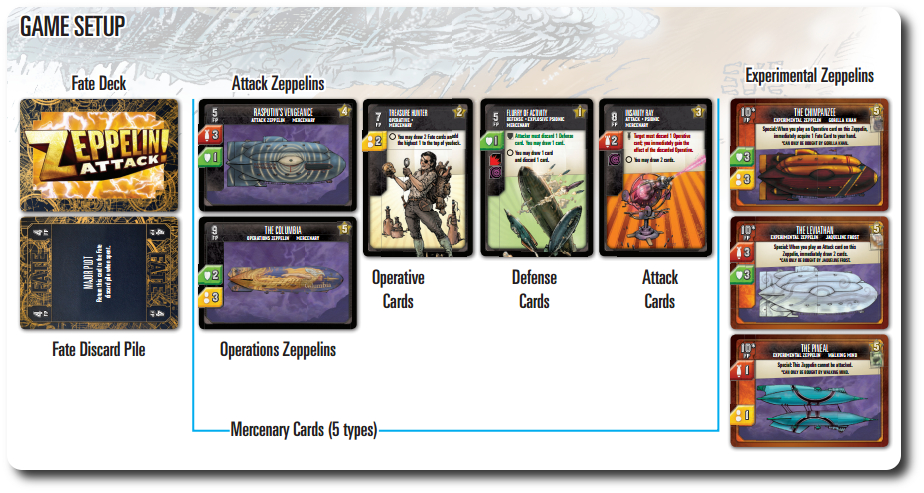
Sixth, each player places their Flagship in front of them and shuffles their Starting deck of cards. After shuffling, each player places their Starting deck face-down to indicate they are ready to play. This is the player’s draw deck for the duration of the game. Leave room for a discard pile.
Seventh, each player draws 5 cards from their draw deck and the game is ready to begin. Determine who will go first using any method you like and start kicking some zeppelin butt.
General Inspection
Before we jump into the game, it’s worth taking a moment to inspect the cards we will be using. This is a deck-building game, meaning players will be focused on not only taking out their opponents, but also creating a deck of cards that will help them achieve victory. Each of the major card types are summarized here.
Flagships and Zeppelins
Each player starts with a Flagship and an Experimental Zeppelin. The player will have to purchase their Experimental Zeppelin later in the game, but the Flagship is immediately in play at the start of the game. During the game, the player can add airships to their armada.
Flagships and Zeppelins are the platform from which the player will launch all their Operative, Attack, and Defense actions, but there are limits. Each airship has a Capacity value that indicates what card type and how big a Payload they can handle. Not all airships are equal and some are better suited for specific cards. A player can, if they so choose, overload their Zeppelins by adding cards that exceed the airship’s Capacity. This will burden the airship and force it to retreat (discarded), but the player is never completely limited as a result.
The player’s Experimental Zeppelin is reserved for their use, but must be earned. When it’s purchased, it will provide the player with a very power airship and a Special Effect. While the Experimental Zeppelin is not necessary to win the game, it’s an excellent card to add to any player’s deck.

Operative, Attack, and Defense Cards
Operative, Attack, and Defense cards are collectively referred to as Action cards. This is because they are the only cards in the game that allow the player to take 1 or more actions on their turn. Actions include attacking, defending, and collecting Fate cards for the most part. Each card specializes in one of these actions and must be attached to an available airship. Each of these cards has a Payload value that is matched to the airships Capacity value. Players will want to make sure the Payload value never exceeds the Capacity value or they will lose the airship to their discard pile.
Operative cards represent the player’s crew and special agents. The player starts with a few crew, which will be enough to get their Flagship off the ground, but they’ll need to recruit more if they want to succeed. An Operative card’s main use is providing the player Fate cards via their General Effects, but they also provide valuable Victory Points.
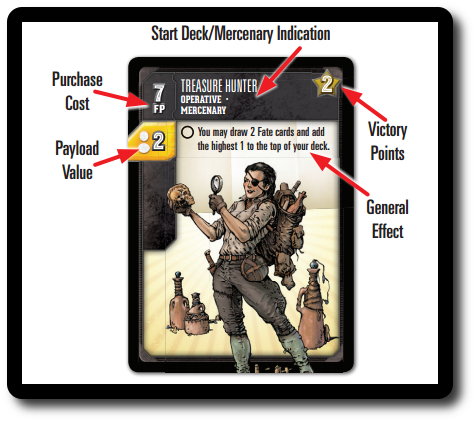
Attack cards allow the player to target 1 opponent’s airship. There are 4 Attack Types. These are Cold, Psionic, Electric, and Explosive. Knowing the Attack Type when resolving combat is important since a defensive counter can only block the same Attack Type (Cold blocks Cold, for example). Attack cards list two effects. The Attack Effect is only resolved if the player successfully attacks the target. The General Effect is resolved regardless of the outcome of combat.
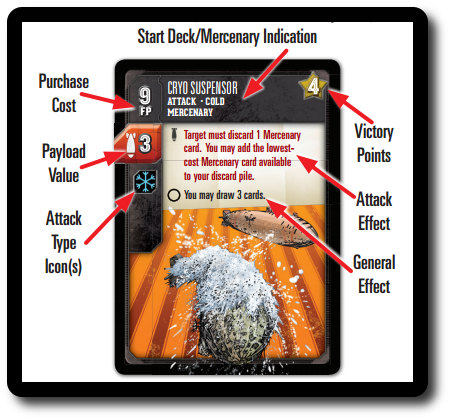
Defensive cards are used to counter Attack cards, but they can also be used for their General Effect during the player’s turn when they are not being directly attacked. If the player is being attacked, they play their Defense card out of turn as a response to their opponent’s attack. To be played, the Defense card must have a Defense Type that matches the Attack card’s Attack type. If it does, and the player can play the Defense card to the airship, the attack fails. The player can then resolve the Defense Effect and the General Effect.
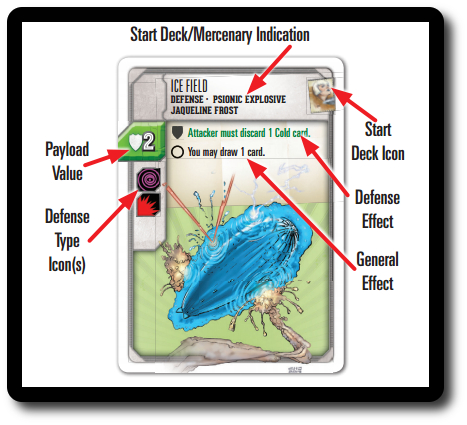
Fate and Fortune
Fate cards have two purposes. Their most important purpose is to provide Fate Points. Fate Points are the currency in the game, allowing the players to purchase better cards and streamline their deck to match their preferred strategies and tactics. Their second and less popular purpose is to inject the game with random Fate Effects that often impact all the players. Never to a point where it will upset the balance of the game, but a few Fate Effects might upset a player’s immediate plans.

Balloon Fight
Zeppelin Attack! is played in rounds and turns with no set number of rounds in the game. A player’s turn is broken down into a small number of sequential phases. A player’s turn is summarized here.
Phase 1: Launch Zeppelins and Take Actions
Each player starts the game with their Flagship in play, providing the players a platform to launch Operative, Attack, and Defense actions. One airship, however, will not do. A player must build up their armada of Zeppelins if they want a chance to win. Any Zeppelin cards the player might have in their hand can be played in front of them at no cost. When played, Zeppelin cards go next to the player’s Flagship. This area is referred to as the player’s Armada. A player is never required to play a Zeppelin card if they don’t want to.
After Zeppelins are played (or not), the player can now take as many actions as they like as long as they are able to follow 2 very simple rules. First, only 1 Operative, 1 Defense, or 1 Attack card can be played on the player’s Flagship or Zeppelins at a time. When played, they are placed on the Flagship or Zeppelin and remain there to indicate that the airship has been used. Second, the player can only play Operative, Defense, and Attack cards to airships that can use them, as indicated by the colors on the Mercenary cards (green, yellow, and red). Players can overload their Zeppelins, but never their Flagship.
Based on the cards played, the player will now resolve their actions in whatever order they think is best. After resolving their cards, they remain on the airships until the end of the player’s turn.
Operative Actions
Operative cards will provide Fate cards, allowing the player to draw 1 or more. The General Effect listed on the Operative action card will describe how the card is resolved. Some Fate cards have a Fate Effect, as well as providing Fate Points. The Fate Effects are resolved when the player acquires the Fate card. Acquiring a card is a fancy way of saying “putting the card in the player’s hand”.
Defense Actions
Players can play Defense cards on their turn, but doing so puts them at risk until their next turn as you will soon learn. When played on the player’s turn, only the General Effect is used since they are not being attacked.
Attack Actions
Ah, now we are getting to the fun part! COMBAT! When an Attack card is played, the player must announce their target. The opponent who owns the airship being targeted can now play 1 Defense card, but only if the Defense card matches the Attack card’s Attack Type. If a player attacks a player’s Flagship, the opponent can immediately draw 1 card from their draw deck. Combat can go one of two ways…
If the opponent plays a Defense card, the attack fails. The opponent now resolved the Defense card’s Defense Effect and General Effect. The Defense card is then discarded. If the target was a Zeppelin and the opponent overloaded it with the Defense card, the Zeppelin is also discarded at this time. Then the player resolve their Attack card’s General Effect, discarding the card afterwards and the Zeppelin if it was overloaded.
If the opponent does not play a Defense card, the player resolves their Attack card’s Attack Effect and General Effect. The opponent’s targeted Zeppelin is then discarded (Flagships never retreat and always stay in play). The player can then draw 1 Mercenary card from the middle of the playing area and place it underneath their Flagship. This card will be counted as 1 Battle Point at the end of the game.
Phase 2: Buy Mercenaries
The player can now spend their Fate cards for the Fate Points to purchase additional Mercenary cards and their Experimental Zeppelin. The player’s Starting deck and crew are pretty good, but the mercenaries are better. Players should attempt to replace and “upgrade” what they have in their hand. Or, if they prefer, load up on specific cards.
The mercenaries that are available to the player are shown face-up. Each of these cards has a Fate Point value that must be match or exceeded by the total number of Fate Points the player has on all their Fate cards currently in their hand. The player can skip this phase if they like (buying nothing), play a few of their Fate cards, or all their Fate cards. The total number of Fate Points from the played Fate cards can be used to buy as many of the Mercenary cards as the player wants, but they do not get change if there are Fate Points left over. Players should also take note of any Effects of cards in play to determine if they have any discounts or bonuses during this phase of their turn.
The only cards the player can never purchase (other than those they cannot afford) are the Experimental Zeppelins that belong to their opponents. These are reserved and will remain in the middle of the playing area until purchased.
All purchased cards go into the player’s hand. If the player purchases an Operative, Attack, or Defense card, they may Purge another Operative, Attack, or Defense card from their hand, placing it underneath their Flagship for 1 Battle Point. The player CANNOT Purge the card they just purchased. Purging is the ONLY way a player can “trash” cards they no longer need. Removing cards from the players deck is an important aspect of deck-building games. Without the ability to obtain better cards and get rid of weak cards, the player’s draw deck becomes bloated. Purging is always optional, but player should never forget they can use it.
Played Fate cards are discarded after they are used, meaning players do not get to keep circulating their Fate cards through their deck and hand. This is important for 2 reasons. First, Operative cards are the best way to get Fate cards and Fate cards are the only way to get upgrades. Second, Fate cards give the player buying power, but they also give the player points at the end of the game. A player needs to determine if the Fate card is better used for purchasing or for possibly winning the game.
Phase 3: Cleanup, Discard, and Draw
Any Operative, Attack, and Defense cards currently on an airship are now discarded. If the Zeppelin was overloaded (Payload value of Action card is great than the Zeppelin card’s Capacity value), the airship is also discarded.
If the player has more than 5 cards in their hand, they must discard down to 5 cards. A player can keep the cards in their hand or discard even more cards, including all the cards in their hand. Discarded cards go to the top of the player’s discard pile.
The player then draws back up to 5 cards. If there are not enough cards in the draw pile, the discard pile is shuffled and placed face-down to create the new draw deck.
The player’s turn is now over and the next player in turn order sequence can now go.
Endgame and Victory
The endgame is triggered when any 3 of the Mercenary draw piles are depleted. Players continue to take their turn until the turn order sequence returns to the starting player and ends the round. All the players now count their total score.
- Count the number of cards (not the Victory Point values) underneath the player’s Flagship. Each card is worth 1 Battle Point. For every 1 Battle Point, the player earns 1 Victory Point. Set these cards to one side.
- Collect all the player’s cards (in hand, in play, and in the discard pile) and count the total number of Fate Points not spent. Whoever has the largest number is awarded 3 Victory Points. Set the Fate Cards to one side.
- Total the Victory Point values of all the cards that remain in the player’s hand.
- Add the Victory Points from the player’s hand, the 3 Victory Points from the Fate cards (if they had the largest number of unspent Fate Points), and the Victory Points derived from the player’s Battle Points. This is the player’s total Victory Point value.
The player with the highest Victory Point value wins the game and rules the skies. Ties are broken by Battle Points.
To learn more about Zeppelin Attack!, visit the game’s web page.
Final Word
The Child Geeks who have played deck-building games before jumped right in Zeppelin Attack! without any problems whatsoever. They were surprised that they lost their “money” when they spent Fate Points and really liked bringing into play all the airships they could. According to one Child Geek, “The only thing I don’t like about this game is that it doesn’t have more starting characters. I didn’t want to be the ice queen.” Another Child Geek said, “I really like this. So far, this and Star Realms are my favorite deck-building games, but I’m starting to like Zeppelin Attack! more and more.” For those Child Geeks who were not familiar with deck-building games, they found Zeppelin Attack! to be easy to learn and fun to play. According to one of these Child Geeks, “I was confused at first, but then I remembered to just match colors to numbers and everything made sense.” When the airships were parked and everyone jumped onto solid land, all the Child Geeks voted to approved Zeppelin Attack!
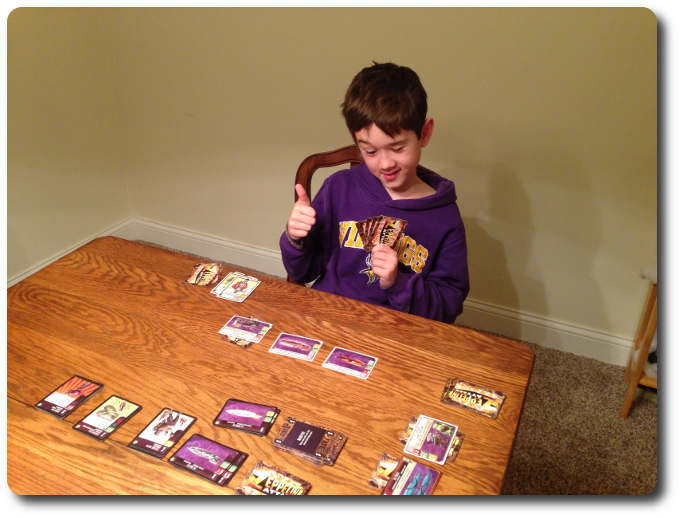
My son gives me his “thumbs up” vote for the game right after he turns one of my airships into a fireball
The Parent Geeks really enjoyed Zeppelin Attack! According to one Parent Geek, “I am so glad you introduced this game. I was getting tired of the really big and card-heavy deck-building games. This game is the perfect size.” None of the Parent Geeks had problems learning the game and they found teaching the game to be very straight forward. One Parent Geek remarked, “I thought this game was going to be too easy at first, but I can see now that it’s easy to play, but not at all easy to win.” One Parent Geek was not pleased with the game, finding it to be too simple and limited. According to him, “It’s a good enough game, but you can only ever play airships, attack, and work on a reducing the Mercenary decks as fast as you can to win. I didn’t find the game that interesting.” None of the other Parent Geeks agreed, however, and the majority voted to approve Zeppelin Attack!
The Gamer Geeks were surprisingly pragmatic when it came to Zeppelin Attack! Normally they are rather zealot-like when preaching from their elitist pulpit. A few of the Gamer Geeks started to compare the game to larger and more complicated deck-building games, but a number of Gamer Geeks jumped to the game’s defense. According to one Gamer Geek, “I don’t think it’s right to compare this game to the larger deck-builders. This is a smaller game and has its own unique limitations and strengths.” Another Gamer Geek said, “I like this game. I think it’s an excellent filler. There’s enough to it where I need to take the game seriously, but it’s not a game I think that will overly challenge me. Which is fine.” And then the Gamer Geeks debated what “made a good deck-building game”. They had lots of ideas, from lots of cards to building combos. That’s when a Gamer Geek said, “Ah! That’s what this game is missing! I cannot build my machine! I am just collecting cards that will do the job, not collecting cards to build on top of each other.” All of the Gamer Geeks agreed on that point, but it didn’t seem to matter within the scope of the game. “It is what it is and that’s pretty good”, remarked one Gamer Geek when the votes were counted. All the Gamer Geeks agreed that Zeppelin Attack! wasn’t the best deck-builder they had ever played, but none of them thought it was a bad game either.
I very much enjoyed Zeppelin Attack! A number of the game’s rules and methods of play are intriguing, surprising me at times at how simplistic it was, while at the same time making me think harder than what I thought necessary. My favorite aspect of the game is the airships, which not only act as “batteries” but as launching pads for all my actions. I liked this and made building my armada of airships a meaningful experience. Did I want to load up on combat airships or focus more on operations? Regardless of my choice, I was never boxed in. Airships give players options while slightly limiting others. At no time did I ever feel like I was lost or incapable of doing something that would be a meaningful move towards my goals.
I have heard some say that the game is limited in scope and it’s too “breezy”. I do think this is a light game and its lack of depth of game play can be easily attributed to the game’s size. Design-wise, I think it’s excellent and does a great job of keeping the players on track, in the game, and engaged from the very first card to the very last. The Starter decks were a clever way to get players into the game with unique cards that all have the same general strength, the Experimental Zeppelin serves as the proverbial carrot, and the many airships a player can hire on makes it fun to build your armada.
The only fault this game has, if we can even call it that, is the number of cards it comes with. Play this game a few times and you’ve seen everything the game can provide. There is variety in the game, but it’s fairly limited. This makes the game feel a bit predictable at times when the same cards keep coming up.
This is a light deck-building game. It lacks the kind of depth players of more complicated deck-building games enjoy, but I doubt it’ll disappoint. This is a perfect game to introduced to new players not familiar with deck-building games, veteran players who are looking for a lighter deck-building game to enjoy, and everyone in between. Do play this game when the opportunity presents itself.
This game was given to Father Geek as a review copy. Father Geek was not paid, bribed, wined, dined, or threatened in vain hopes of influencing this review. Such is the statuesque and legendary integrity of Father Geek.




Pingback: Zeppelin Attack! Doomsday Weapons Game Expansion Review - Father Geek